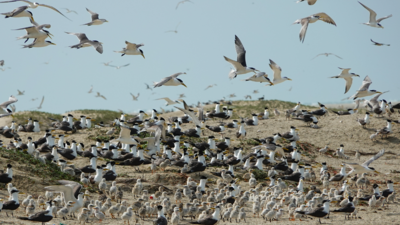Breakthrough seabird discovery: Large breeding grounds found on Gulf of Mannar sandbars | Chennai News – The Times of India

A team of researchers conducted a study over nearly eight years on the sandbars of the ancient Ram Setu, also known as Adam’s Bridge. They returned with key findings on seabirds, including the first confirmed nesting of five tern species, which were previously considered migrants by bird researchers.
The findings were published in the international peer-reviewed journal, ‘Journal of Threatened Taxa’, a few days ago.
The research team included H Byju and H Maitreyi from the Centre of Advanced Study in Marine Biology, Annamalai University, N Raveendran from the Madurai-based Iragukal Amritha Nature Trust, D A Marshal from the wildlife division, Gulf of Mannar Marine Biosphere Reserve, and S Ravichandran from the department of zoology, Government Arts and Science College, Nagercoil.
Byju and Raveendran, who worked in the area for many years, were the researchers who earlier discovered a new species of Hanuman Plover in 2023.
The pursuit of seabirds began in 2017–18 when Byju accompanied veteran researcher S Balachandran from the Bombay Nature History Society for a govt-sponsored study in the Gulf of Mannar.
Balachandran studied seabirds even before the road bridge was constructed to connect Rameswaram Island with the mainland in the 1980s. “During the study, he shared some of his observations of seabirds in the region, and we decided to follow those hints,” says Byju.
For eight years, this team of researchers, with the help of the Wildlife Division of the Gulf of Mannar Marine National Park, undertook numerous boat journeys to the sandbars—the seven sandbars within the International Maritime Boundary Line of India—to study the seabirds. “Our prolonged research helped us to unearth one of the largest breeding grounds of seabirds,” said Raveendran.
Ram Setu, the chain of sandbars connecting Rameswaram Island with Sri Lanka, lies partially in India and Sri Lanka, and these sandbars 1 to 7 within Indian territory remain largely isolated due to restricted access. The reserve supports regional endemic breeding species like the Hanuman Plover, rare migratory species such as the Arctic Skua and Pomarine Skua, and unusual vagrants like the Light-mantled Albatross.
Sandbar VII is approximately 2.5 km in length and 1.5 km in width and consists of habitats like sand dunes and shallow seawater pools. Surveys were conducted using boats on all the sandbars except Sandbar VII, where surveys were conducted on foot due to extensive breeding activity, according to researchers.
Seabirds are key indicators of marine ecosystem changes due to their long lifespans and dependence on terrestrial breeding habitats and marine food sources, said Maitreyi. Seabirds reflect anthropogenic and environmental impacts, including climate change, fisheries impact, and prey stock availability, supporting marine conservation efforts.
Thus it is important that we study them. However, their study also revealed that these seabirds on these sandbars face threats of poaching and pollution, she stated.
Though they spotted signs of poaching from both the Indian and Sri Lankan sides, the presence of many chicks with parents suggests that it was not alarmingly rampant. However, plastic pollution is a concern, said Byju.
“Indiscriminate dumping of solid waste on the coasts from India and Sri Lanka washes up on these sandbars due to currents,” he pointed out.
“We should ideally undertake a cleaning drive to remove the plastic choking the bird habitat. Surveillance on both sides should be strengthened to protect this shared ecological treasure trove,” says Raveendran.
The study underscores the delicate balance between conservation and geopolitical challenges in this disputed maritime zone, urging policymakers to prioritise ecology alongside security. “These sandbars are a lifeline for seabirds. Their isolation has preserved them—but without immediate protection, climate change and human interference could wipe out these colonies,” says Byju.
















